 W
WAcer × conspicuum, called the snakebark maple, is a hybrid species of maple. It was created in the Netherlands by crossing Acer davidii with Acer pensylvanicum.
 W
WAsplenium × ebenoides is a hybrid fern native to eastern North America, part of the "Appalachian Asplenium complex" of related hybrids. The sterile offspring of the walking fern (A. rhizophyllum) and the ebony spleenwort (A. platyneuron), A. × ebenoides is intermediate in morphology between its two parents, combining the long, narrow blade of A. rhizophyllum with a dark stem and lobes or pinnae similar to those of A. platyneuron. While A. × ebenoides is generally sterile, fertile specimens with double the number of chromosomes are known from Havana Glen, Alabama. These fertile allotetraploids were reclassified as a separate species named A. tutwilerae in 2007, retaining the name A. × ebenoides for the sterile diploids only.
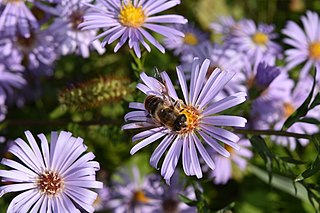 W
WAster × frikartii, called Frikart's aster, is a hybrid of European Michaelmas daisy, Aster amellus, and Thomson's aster, Aster thomsonii. It was created by Swiss plant breeder Carl Ludwig Frikart. Its cultivars 'Mönch' and 'Wunder von Stäfa' have gained the Royal Horticultural Society's Award of Garden Merit, and are also considered by them to be good plants to attract pollinators.
 W
WCalamagrostis × acutiflora, called feather reed-grass, is a naturally occurring hybrid species of grass in the genus Calamagrostis, occasionally found in Europe and Asia. Its cultivar 'Karl Foerster' has gained the Royal Horticultural Society's Award of Garden Merit.
 W
WCalystegia × pulchra, commonly known as hairy bindweed, is a species of morning glory. It is a climbing plant that may exceed three meters in height. The bright pink corolla may be 5 to 7 centimeters and has distinct white stripes. This species is a weedy wildflower which has naturalized in many areas, including much of Europe and is also grown as an ornamental plant.
 W
WColchicum × agrippinum is a species of flowering plant in the family Colchicaceae. It is considered to be a hybrid between C. variegatum and C. autumnale, and not a true species, although this is not certain. The genus and the species are commonly called autumn crocus, naked lady or meadow saffron.
 W
WColchicum × byzantinum, the Byzantine meadow saffron, is a species of flowering plant in the family Colchicaceae with a long history of cultivation, and no certain place of origin. It is thought to be a hybrid of other species.
 W
WCornus × unalaschkensis is a species of flowering plant in the Cornaceae, the dogwood family. Common names for the plant include Alaskan bunchberry, western cordilleran bunchberry, or simply western bunchberry.
 W
WCrocosmia × crocosmiiflora, montbretia, is a garden hybrid of C. aurea and C. pottsii, first bred in 1880 in France by Victor Lemoine. The name "montbretia" is often found in horticultural literature.
 W
WEchinocereus × neomexicanus is a natural hybrid between Echinocereus coccineus subsp. rosei and Echinocereus viridiflorus subsp. chloranthus. Lyman Benson confused the plant with Echinocereus coccineus subsp. rosei under the name Echinocereus triglochidiatus var. neomexicanus. The plant was originally described by Paul Carpenter Standley in Bulletin of the Torrey Botanical Club 35:87 (1908) based on a specimen growing in the cactus garden of the New Mexico College of Agriculture and Mechanic Arts from among hundreds of specimens he had collected from the mesa west of the Organ Mountains.
 W
WEquisetum × trachyodon is a nothospecies of Equisetum. Sometimes, it is considered as an individual species: Equisetum trachyodon.
 W
WEucalyptus × brachyphylla is a mallee or small tree that is endemic to a small area in Western Australia. It has rough bark near the base of the trunk, smooth greyish bark above, egg-shaped to elliptic adult leaves, flower buds in groups of seven in leaf axils, white flowers and conical fruit.
 W
WEucalyptus × balanites, commonly known as Cadda Road mallee, is a tree or a mallee that is endemic to a small area of the south-west of Western Australia. It has rough, corky or flaky bark, lance-shaped adult leaves, flower buds in groups of eleven, creamy-white flowers and hemispherical to cup-shaped fruit.
 W
WEuphorbia × martini, or Martin’s spurge, is a hybrid between two species of flowering plant, E. amygdaloides × E. characias subsp. characias in the spurge family Euphorbiaceae. It was found growing wild in southern France. Growing to 60 cm (24 in) tall and broad, it is a dwarf evergreen subshrub with narrow grey-green leaves and in late spring and early summer, sprays of lime green flowers, often with a red or maroon eye. It is useful as a spreading, weed-smothering groundcover. Though hardy down to −15 °C (5 °F), it is a Mediterranean plant best grown in a sheltered spot in well-drained soil in full sun.
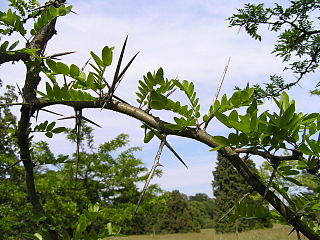 W
WGleditsia × texana, the Texas honey locust, is a tree native to America. It is a naturally occurring hybrid of Gleditsia aquatica × Gleditsia triacanthos.
 W
WGrevillea × gaudichaudii is a prostrate shrub which is endemic to New South Wales. It is a naturally occurring hybrid between Grevillea acanthifolia subsp. acanthifolia and Grevillea laurifolia. It is fast growing and grows to 0.2 to 0.3 metres in height and 1 to 3 metres in width. It is drought and frost resistant. It flowers in spring and summer with toothbrush style blooms which attract small nectar eating birds and insects.
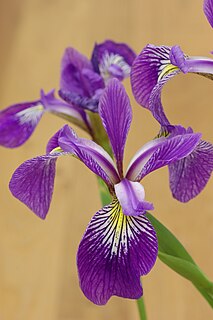 W
WIris × robusta, called the Windermere iris, is a hybrid species of flowering plant in the family Iridaceae. Its parents are Iris versicolor and Iris virginica, both of which are native to North America. Wild populations have been found in Michigan and Ontario, and it has been introduced into Great Britain. It is a rhizomatous perennial, characterised by its violet-blue flowers and purple-flushed foliage. It has a number of cultivars, including 'Gerald Darby', 'Mountain Brook', 'Purple Fan' and 'Nutfield Blue'. Its cultivar 'Dark Aura' has gained the Royal Horticultural Society's Award of Garden Merit.
 W
WLaburnum × watereri, is a naturally occurring hybrid species of Laburnum, native to Central Europe. Its parents are common laburnum, Laburnum anagyroides, and alpine laburnum, Laburnum alpinum. A small deciduous tree or large shrub, it is a popular garden plant, called golden chain tree for its spectacular display of hanging clusters of yellow pea-like blossoms. It can be trained to take forms such as arches and espaliers.
 W
WLarix × czekanowskii is a larch hybrid, between Siberian larch and Dahurian larch.
 W
WLonicera × bella, known as Bell's honeysuckle and showy fly honeysuckle, is a hybrid species of flowering plant in the family Caprifoliaceae. It was first described by Hermann Zabel in 1889. Zabel reported that he grew it in cultivation from seeds obtained from a plant of Lonicera morrowii, but that its appearance suggested the influence of L. tatarica. It has escaped from cultivation and become an aggressive invasive species in central and eastern parts of the United States.
 W
WMalus × robusta, called Siberian crab apple along with other members of its genus, is a hybrid species of flowering plant in the family Rosaceae. It is the result of a cross between Malus baccata and Malus prunifolia. It is being studied for its resistance potential to fire blight. Known for its attractive fruit that remain on the tree well into winter, its cultivar 'Red Sentinel' has gained the Royal Horticultural Society's Award of Garden Merit as an ornamental.
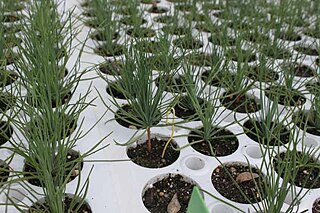 W
WPinus × sondereggeri is the only named southern pine hybrid. Common names include Sonderegger pine and bastard pine. It is a naturally occurring cross between loblolly pine (P. taeda) and longleaf pine (P. palustris). It was originally described by H. H. Chapman (1922), who named it after its discoverer, V. H. Sonderegger, a state forester of Louisiana. This pine usually occurs singly or in small groups where both loblolly and longleaf pines overlap in range. Because the flowering of both parental trees usually occurs at the same time of year, no phenological barrier exists, thus the two freely cross.
 W
WPlatanus × acerifolia, the London plane, London planetree, or hybrid plane, is a tree in the genus Platanus. It is often known by the synonym Platanus × hispanica. It is usually thought to be a hybrid of Platanus orientalis and Platanus occidentalis. Some authorities think that it may be a cultivar of P. orientalis.
 W
WPolygala × dalmaisiana, the sweet pea shrub, is an ornamental plant of genus Polygala in the family Polygalaceae. This plant is attractive to hummingbirds, and it is often propagated by cuttings.
 W
WPolygonatum × hybridum, the garden Solomon's-seal, is a hybrid flowering plant, which is a cross between common Solomon's-seal and angular Solomon's-seal.
 W
WPopulus × acuminata or Populus acuminata, the lanceleaf cottonwood, is a species of Populus native to the Rocky Mountains of North America. It is a naturally occurring hybrid of narrowleaf cottonwood, Populus angustifolia, and eastern cottonwood, Populus deltoides, found where their ranges overlap. It is planted as a shade tree in cities in the Rockies, preferring to grow at elevations between 4,500 and 8,500 ft. Given the plant's proclivity to send out shallow roots and suckers, some municipalities prohibit their planting. Fort Collins, Colorado, by contrast, has many lanceleaf cottonwoods gracing its avenues.
 W
WPopulus × canadensis, known as Canadian poplar or Carolina poplar, is a naturally occurring hybrid of Populus nigra and Populus deltoides. It is a vigorous, broadly columnar, deciduous tree growing to 40 m (130 ft), which is commonly used by landscape architects. Cultivars include 'Robusta' and 'Aurea', which has won the Royal Horticultural Society's Award of Garden Merit.
 W
WPopulus × canescens, the grey poplar, is a hybrid between Populus alba and Populus tremula. It is intermediate between its parents, with a thin grey downy coating on the leaves, which are also much less deeply lobed than the leaves of P. alba. It is a very vigorous tree with marked hybrid vigour, reaching 40 m tall and with a trunk diameter over 1.5 m – much larger than either of its parents. Most trees in cultivation are male, but female trees occur naturally and some of these are also propagated.
 W
WQuercus × crenata, commonly known as Spanish oak, is tree in the family Fagaceae. It is a hybrid between the European trees Turkey oak and cork oak. This hybrid has in the past often been called Quercus × hispanica, a name that refers to presumed hybrids between Quercus tlemcenensis and Quercus suber.
 W
WQuercus × turneri, known as Turner's oak, is a hybrid species of white oak native to Spain. It is a naturally occurring hybrid of holm oak and pedunculate oak, found where their ranges overlap, but was first described from cultivation. A semi-evergreen tree of small to medium size with a rounded crown; it was originally raised at the Holloway Down Nursery of Spencer Turner, Leyton, Essex, UK, noted by the zoologist Jean-Baptiste Lamarck at Trianon, Versailles in 1783, as the chêne de turnère. An early specimen was planted at the Royal Botanic Gardens, Kew in 1798; it was uprooted in the Great Storm of 1987 but resettled in the ground and then increased its healthy growth. Its 'Pseudoturneri' cultivar has gained the Royal Horticultural Society's Award of Garden Merit.
 W
WSalix × fragilis, with the common names crack willow and brittle willow, is a hybrid species of willow native to Europe and Western Asia. It is native to riparian habitats, usually found growing beside rivers and streams, and in marshes and water meadow channels. It is a hybrid between Salix euxina and Salix alba, and is very variable, with forms linking both parents.
 W
WSalvia × superba is a widely grown Salvia hybrid. Its origins are unknown, though it first appeared in cultivation, and its parents are believed to include Salvia × sylvestris and Salvia amplexicaulis. Salvia nemorosa has also been suggested as a direct parent or close relative, but with so many similarities between these species and hybrids, there is no conclusive evidence. It is often mistakenly called Salvia superba.
 W
WSarracenia naczii is a hybrid of Sarracenia flava and Sarracenia rosea carnivorous plants in the family Sarraceniaceae, described by T. Lawrence Mellichamp.
 W
WSaxifraga × arendsii, the mossy saxifrage, is a perennial garden flowering plant.
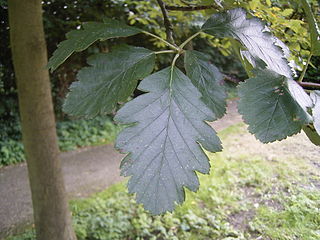 W
WSorbus intermedia, the Swedish whitebeam, is a species of whitebeam found in southern Sweden, with scattered occurrences in easternmost Denmark (Bornholm), the far southwest of Finland, Estonia, Latvia and northern Poland.
 W
WSorbus × hybrida, the oakleaf mountain ash, Swedish service-tree or Finnish whitebeam, is a hybrid species of whitebeam native to Norway, eastern Sweden, southwestern Finland, and locally in Latvia.
 W
WTaxus × media, more commonly known as the Anglojap yew or simply Taxus media, is a conifer created by the hybridization of yew species Taxus baccata and Taxus cuspidata. This hybridization was thought to have been performed by the Massachusetts-based horticulturalist T.D. Hatfield in the early 1900s.
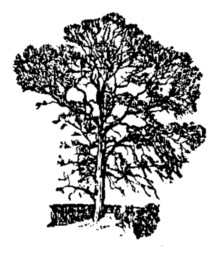 W
WUlmus × diversifolia, also known as the diverse leaved elm, was originally described by Melville in 1939 as a new species, U. diversifolia, though he later believed it a natural hybrid of Coritanian elm, Plot elm and Wych elm. He recorded its distribution in Hertfordshire, between Hatfield, Hertford and Watton-at-Stone, and in Suffolk, where it was common along the coastal plain from Ipswich and Felixstowe to Lowestoft and Beccles, occurring inland as far as Diss and Debenham, and probably extending further north into Norfolk and south towards Colchester, Essex. He accordingly referred to it as "the East Anglian elm".
 W
WViburnum × bodnantense, the Bodnant viburnum, is a Group of hybrid flowering plant cultivars of garden origin. They originate in a cross between V. farreri and V. grandiflorum made by Charles Puddle, head gardener to Lord Aberconway at Bodnant Garden, Wales around 1935.
 W
WViburnum × burkwoodii, the Burkwood viburnum, is a hybrid flowering plant in the family Adoxaceae. It is a cross of garden origin between V. carlesii and V. utile, grown for its early, strongly scented flowers.
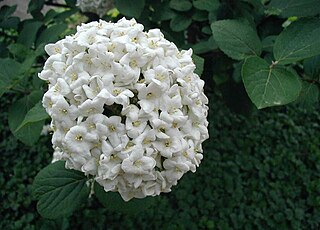 W
WViburnum × carlcephalum, common name fragrant snowball, is a hybrid flowering plant in the family Adoxaceae, of garden origin. It is a cross between V. carlesii and V. macrocephalum.
 W
WViola × williamsii, known as hybrid horned pansy, tufted pansy, or just horned pansy, is a hybrid between Viola cornuta and V. × wittrockiana. It differs from V. cornuta in having wider, slightly overlapping petals, the lateral ones directed outwards or upwards, and more deeply dentate to laciniate stipules with the apical lobe clearly narrowed towards the base. It differs from V. × wittrockiana in at least one of the following characters: perennial habit, scented flowers and a longer spur.
 W
WWashingtonia × filibusta is a hybrid of the species Washingtonia filifera and Washingtonia robusta. Stores do not sell purebreds, they sell the hybrid only. The hybrid does not look too different from the purebred, but is more hardy to cold than W. robusta, especially wet cold.
 W
WYucca × schottii is a plant species in the genus Yucca, native to southern Arizona, southwestern New Mexico, and the northern parts of Sonora and Chihuahua. The common names are Schott's yucca, hoary yucca, and mountain yucca. The "×" in the name indicates that this is a nothospecies, regarded as being a natural hybrid between two other species. In this case, Yucca × schottii is believed to have originated as a hybrid between Y. baccata and Y. madrensis. Yucca × schottii is firmly established and does reproduce freely in the wild.